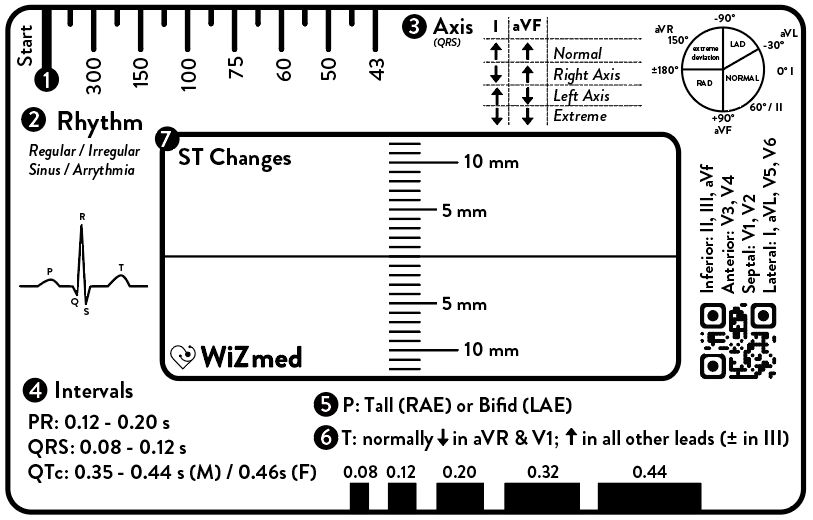WiZmed 7-Step ECG Ruler
Your Step-by-Step Approach to Reading ECGs Confidently
In healthcare, having an approach is everything. Whether it's chest pain, shortness of breath, or dizziness—there's a structured way to tackle it. The WiZmed ECG Ruler gives you that same structured approach for ECGs—so you never miss a beat.
✅ What is it?
A pocket-sized ECG ruler designed by medical students and doctors to simplify and systematise ECG interpretation. It breaks every ECG down into 7 easy steps—ensuring you cover everything, every time.
📦 What's on the Card?
- Rate scale (standard 300, 150, 100, etc.)
- Rhythm assessment guide
- Axis quadrant tool
- P and T wave interpretation tips
- ST segment elevation/depression box
- Interval reference ranges
- QR code to tutorial page

🧠 The 7-Step Approach to Reading Any ECG
Follow these steps systematically to never miss important findings
Rate
Use the top ruler (300-43) to estimate heart rate. Line it up with the R waves—quick and accurate.
💡 Tip: 1 large box = 300 bpm, 2 boxes = 150 bpm, 3 = 100 bpm…
Rhythm
Ask: is the rhythm regular or irregular? Is there a P wave before every QRS?
💡 Tip: Sinus or not? Any dropped beats?
Axis (QRS Axis)
Use the axis quadrant visual to determine normal axis, left/right axis deviation, or extreme axis deviation.
💡 Tip: Line up leads I and aVF, and apply the quadrant rule.
P Waves
Are the P waves tall, peaked, or bifid? This helps identify right or left atrial enlargement.
💡 Tip: Use the diagram for comparison.
T Waves
Check T wave direction: Normally inverted in aVR and V1, upright in other leads.
💡 Tip: T-wave inversions can signal ischemia, electrolyte issues, or more.
Intervals
Use the built-in scale to measure PR (0.12–0.20s), QRS (0.08–0.12s), QTc intervals.
💡 Tip: This helps pick up conduction delays, blocks, and prolonged QT.
ST Segment
Use the ST elevation box to assess for STEMI, pericarditis, or ischemia.
💡 Tip: Compare against the 1 mm and 2 mm markings to assess quickly and accurately.
📐 How to Use the ECG Card
Let's break down exactly how to use each section on your ECG ruler with a real ECG.

🧮 Top Ruler
Use this to calculate heart rate by counting the large boxes between R waves. Simply align with consecutive R waves and read the rate directly.
🔁 Rhythm Guide
Use the rhythm assessment checklist to systematically evaluate rhythm regularity and P-QRS relationship.
🧭 Axis Quadrant
Place the ruler over leads I and aVF to determine whether the axis is normal, left, right, or extreme deviation.
📏 ST Elevation Box
Use the mm scale to quickly measure ST elevation or depression in any lead. Critical for STEMI diagnosis.
⏱️ Interval Bar
Quickly check PR, QRS, and QT intervals using the calibrated scale. Essential for identifying conduction abnormalities.
💡 Pro Tips for Using Your Card
Always Start with Rate & Rhythm
These are your foundation - get them right first before moving to other steps.
Use Standard Paper Speed
The card is calibrated for 25mm/s paper speed - check this first!
Practice Makes Perfect
Use the card on every ECG - muscle memory will make you faster and more accurate.
Don't Skip Steps
Even if something looks obvious, go through all 7 steps systematically.
🎓 Who Is This For?
Medical Students ✅
Perfect for learning ECG interpretation
Interns & Community Service Doctors ✅
Essential for on-call situations
Paramedics & Nurses ✅
Quick reference for emergency care
Anyone Who's Panicked During ECG Exams ✅
Build confidence with structured approach
📹 Learn by Watching
Walk through all 7 steps in under 2 minutes
🎥 Demo Video
Click to watch the complete walkthrough
🛒 Get Your ECG Card
Ready to simplify ECGs forever?
Only R49. Designed in SA by medical students, for medical students.
👉 Buy now on WiZmed.co.za